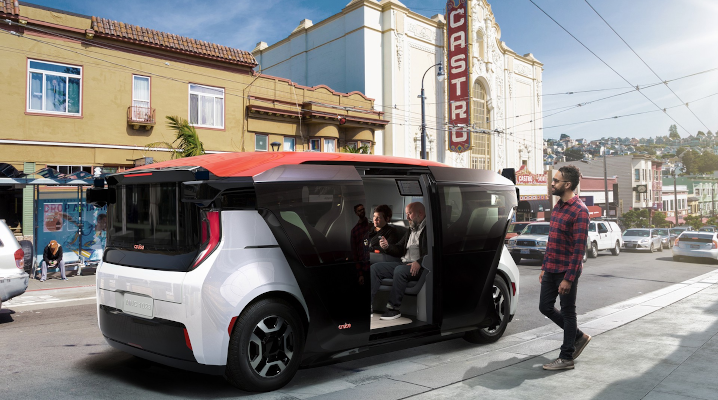 CLOUD
CLOUD
 CLOUD
CLOUD
 CLOUD
CLOUD
General Motors Co.’s Cruise LLC subsidiary on Tuesday evening unveiled the Origin, a self-driving vehicle that doesn’t have a steering wheel or pedals.
The Origin (pictured) is the production-ready successor to a car design GM introduced in early 2018. The automaker has preserved the original idea of having an interior with no traditional driver controls but made a number of big changes in other areas.
For starters, the Origin isn’t a car. It’s an electric van that can hold up to six passengers, and it will be offered via a ride-sharing service.
The Origin sees with the help of a sensor array made up of several different components. There are lidar units, radars, cameras and thermal imaging systems that provide visibility at night. The sensors feed their data to an artificial intelligence navigation platform that runs on a computer tucked away in the trunk.
Cruise said all the components of the autonomous driving system, from the lidar units to the AI computer, are modular so they can be replaced without a long stay at the garage. The hope is that easing maintenance will make the Origin cheaper to operate in the long run.
The modular design is part of a broader strategy to lower the cost of autonomous rides. Cruise has based the Origin on a vehicle chassis that will also be used in dozens of other GM electric vehicle models, which will enable economies of scale, and the van was designed to enable an exceptionally long service life. Cruise estimates that the Origin will last for a million miles or more, six times what an average car can bear.
The GM subsidiary’s end goal is to make its planned autonomous ride-sharing service competitive in price with owning a private vehicle. A typical Uber ride today runs about $2 per mile, maintaining a personal car costs about half that and Cruise’s objective with the Origin is cut transportation costs by an additional $5,000 per year.
It’s an ambitious goal. Cruise and GM, which reportedly have plans to make as many as 100,000 Origin vans, will have to build out the infrastructure for a large-scale ride-hailing network while fending off competition from rivals such as Alphabet Inc.’s Waymo unit that are doing the same.
Regulatory considerations will add yet more complexity to the picture. Because the Origin lacks traditional driver controls such as a steering wheel, Cruise may face more obstacles to securing government approvals than rivals such as Waymo that use more conventional vehicles.
Support our mission to keep content open and free by engaging with theCUBE community. Join theCUBE’s Alumni Trust Network, where technology leaders connect, share intelligence and create opportunities.
Founded by tech visionaries John Furrier and Dave Vellante, SiliconANGLE Media has built a dynamic ecosystem of industry-leading digital media brands that reach 15+ million elite tech professionals. Our new proprietary theCUBE AI Video Cloud is breaking ground in audience interaction, leveraging theCUBEai.com neural network to help technology companies make data-driven decisions and stay at the forefront of industry conversations.